New Data from Minor Mountainous Lakes as High-Resolution Geological Archives of the Northern Apennines, Italy: Lake Moo
Abstract
1. Introduction
2. Geological and Geomorphological Setting
- -
- Steep slopes (average inclination of 24°) composed of deposits highly susceptible to erosion (i.e., polygenic and monogenic breccias with a pelitic matrix—the Mt. Ragola Complex [32]);
- -
- Absence of lacustrine basins in the upstream part of the catchment;
- -
- Small drainage basin area (1.94 km2);
- -
- One dominant inflow into the lake;
- -
- Lack of regulated flow structures;
- -
- Lack of natural pre-lake sediment storage zones.
3. Materials and Methods
3.1. Geospatial Data
3.2. Coring and Analytical Methods
3.3. Lake Sediment Coring and Paleoflood Reconstruction
4. Results
4.1. Core Analysis
4.1.1. X-Ray Imaging
4.1.2. Magnetic Susceptibility Analysis
4.1.3. XRF Core Scanner
4.1.4. Dating
5. Discussion
- During the final phase of the Little Ice Age (LIA), the study area experienced several flood events (highlighted by the orange circle and green rhombus in Figure 8), which notably altered the morphology of the Lake Moo plain.
- In agreement with the observations from the S1 borehole extracted in July 2017 at the Lake Moo plain [28], two distinct clusters of coarse material are evident at the end of the Holocene Climatic Optimum (HCO) peak (green cross (S1a: 6573–6396 B.P.) and brown cross (S1b: 7027–6785 B.P.) in Figure 8).
- The sedimentological characteristics of samples (S1a) and (S1b) from [28] are similar to sample C3b in the present study.
6. Conclusions
Supplementary Materials
Author Contributions
Funding
Data Availability Statement
Acknowledgments
Conflicts of Interest
References
- Ahlborn, M.; Armon, M.; Ben Dor, Y.; Neugebauer, I.; Schwab, M.J.; Tjallingii, R.; Shoqeir, J.H.; Morin, E.; Enzel, Y.; Brauer, A. Increased frequency of torrential rainstorms during a regional late Holocene eastern Mediterranean drought. Quat. Res. 2018, 89, 425–431. [Google Scholar] [CrossRef]
- Giguet-Covex, C.; Arnaud, F.; Dirk, E.; Jérôme, P.; Laurent, M.; Pierre, F.; Fernand, D.; Pierre-Jérôme, R.; Bruno, W.; Jean-Jacques, D. Frequency and intensity of high-altitude floods over the last 3.5ka in northwestern French Alps (Lake Anterne). Quat. Res. 2012, 77, 12–22. [Google Scholar] [CrossRef]
- Gilli, A.; Anselmetti, F.S.; Glur, L.; Wirth, S.B. Lake Sediments as Archives of Recurrence Rates and Intensities of Past Flood Events. In Dating Torrential Processes on Fans and Cones. Advances in Global Change Research; Schneuwly-Bollschweiler, M., Markus, S., Florian, R.M., Eds.; Springer: Dordrecht, The Netherlands, 2013; Volume 47, pp. 225–242. [Google Scholar] [CrossRef]
- Glur, L.; Wirth, S.B.; Büntgen, U.; Gilli, A.; Haug, G.H.; Schär, C.; Beer, J.; Anselmetti, F.S. Frequent floods in the European Alps coincide with cooler periods of the past 2500 years. Nat. Sci. Rep. 2013, 3, 2770. [Google Scholar] [CrossRef]
- Longman, J.; Ersek, V.; Veres, D.; Salzmann, U. Detrital events and hydroclimate variability in the Romanian Carpathians during the mid-to-late Holocene. Quat. Sci. Rev. 2017, 167, 78–95. [Google Scholar] [CrossRef]
- Schillereff, D.; Chiverrell, R.C.; Macdonald, N.; Hooke, J.M. Flood stratigraphies in lake sediments: A review. Earth-Sci. Rev. 2014, 135, 17–37. [Google Scholar] [CrossRef]
- Stoffel, M.; Butler, D.R.; Corona, C. Mass movements and tree rings: A guide to dendrogeomorphic field sampling and dating. Geomorphology 2013, 200, 106–120. [Google Scholar] [CrossRef]
- Stoffel, M.; Wyzga, B.; Marston, R.A. Floods in mountain environments: A synthesis. Geomorphology 2016, 272, 1–9. [Google Scholar] [CrossRef]
- Swierczynski, T.; Ionita, M.; Pino, D. Using archives of past floods to estimate future flood hazards. Eos 2017, 98. [Google Scholar] [CrossRef]
- Wilhelm, B.; Arnaud, F.; Sabatier, P.; Crouzet, C.; Brisset, E.; Chaumillon, E.; Disnar, J.R.; Guiter, F.; Malet, E.; Reyss, J.L.; et al. 1400 years of extreme precipitation patterns over the Mediterranean French Alps and possible forcing mechanism. Quat. Res. 2012, 78, 1–12. [Google Scholar] [CrossRef]
- Wilhelm, B.; Ballesteros-Cànovas, J.A.; Macdonald, N.; Toonen, W.H.J.; Baker, V.; Barriendos, M.; Benito, G.; Brauer, A.; Corella, J.P.; Denniston, R.; et al. Interpreting historical, botanical, and geological evidence to aid preparations for future floods. WIREs Water 2018, 6, e1318. [Google Scholar] [CrossRef]
- Wirth, S.B. The Holocene Flood History of the Central Alps Reconstructed from Lacustrine Sediments: Frequency, Intensity and Controlling Climate Factors. Ph.D. Thesis, ETH Zürich Bibliography, Zürich, Switzerland, 2013; 179p. [Google Scholar] [CrossRef]
- Wirth, S.B.; Glur, L.; Gilli, A.; Anselmetti, F.S. Holocene flood frequency across the Central Alps—Solar forcing and evidence for variations in North Atlantic atmospheric circulation. Quat. Sci. Rev. 2013, 80, 112–128. [Google Scholar] [CrossRef]
- Sabatier, P.; Moernaut, J.; Bertrand, S.; Van Daele, M.; Kremer, K.; Chaumillon, E.; Arnaud, F. A Review of Event Deposits in Lake Sediments. Quaternary 2022, 5, 34. [Google Scholar] [CrossRef]
- Wilhelm, B.; Amann, B.; Corella, J.P.; Rapuc, W.; Giguet-Covex, C.; Merz, B.; Støren, E. Reconstructing Paleoflood Occurrence and Magnitude from Lake Sediments. Quaternary 2022, 5, 9. [Google Scholar] [CrossRef]
- Zavala, C.; Pan, S. Hyperpycnal flows and hyperpycnites: Origin and distinctive characteristics. Lithol. Reserv. 2018, 30, 1–27. [Google Scholar] [CrossRef]
- Zavala, C.; Ponce, J.J.; Arcuri, M.; Drittanti, D.; Freije, H.; Asensio, M. Ancient Lacustrine Hyperpycnites: A Depositional Model from a Case Study in the Rayoso Formation (Cretaceous) of West-Central Argentina. J. Sediment. Res. 2006, 76, 41–59. [Google Scholar] [CrossRef]
- Zavala, C.; Arcuri, M.; Di Meglio, M.; Gamero Diaz, H.; Contreras, C.A. Genetic Facies Tract for the Analysis of Sustained Hyperpycnal Flow Deposits. In Sediment Transfer from Shelf to Deep Water—Revisiting the Delivery System; Slatt, R.M., Zavala, C., Eds.; AAPG Studies in Geology; AAPG: Tulsa, OK, USA, 2012; Volume 61, pp. 31–51. [Google Scholar]
- Ballesteros-Cánovas, J.A.; Stoffel, M.; St. George, S.; Hirschboeck, K. A review of flood records from tree rings. Prog. Phys. Geogr. 2015, 39, 794–816. [Google Scholar] [CrossRef]
- Regattieri, E.; Zanchetta, G.; Drysdale, R.N.; Isola, I.; Hellstrom, J.C.; Dallai, L. Late glacial to Holocene trace element record (Ba, Mg, Sr) from Corchia Cave (Apuan Alps, central Italy): Paleoenvironmental implications. J. Quat. Sci. 2014, 29, 381–392. [Google Scholar] [CrossRef]
- Zanchetta, G.; Isola, I.; Piccini, L.; Dini, A. The Corchia Cave (Alpi Apuane) a 2 Ma long temporal window on the earth climate. Tech. Period. Natl. Geol. Surv. Italy–ISPRA Geol. Field Trips 2011, 3, 55. (In Italian) [Google Scholar] [CrossRef]
- Schneuwly-Bollschweiler, M.; Stoffel, M.; Rudolf-Miklau, F. Dating Torrential Processes on Fans and Cones. Methods and Their Application for Hazard and Risk Assessment, 1st ed.; Springer: Dordrecht, The Netherlands, 2013; p. 424. [Google Scholar] [CrossRef]
- Giraudi, C. Coarse sediments in Northern Apennine peat bogs and lakes: New data for the record of Holocene alluvial phases in peninsular Italy. Holocene 2014, 24, 932–943. [Google Scholar] [CrossRef]
- Vescovi, E.; Kaltenrieder, P.; Tinner, W. Late-Glacial and Holocene vegetation history of Pavullo nel Frignano (Northern Apennines, Italy). Rev. Palaeobot. Palynol. 2010, 160, 32–45. [Google Scholar] [CrossRef]
- Vescovi, E.; Ammann, B.; Ravazzi, C.; Tinner, W. A new Late-glacial and Holocene record of vegetation and fire history from Lago del Greppo, northern Apennines, Italy. Veget. Hist. Archaeobot. 2010, 19, 219–233. [Google Scholar] [CrossRef]
- Guido, M.A.; Molinari, C.; Moneta, V.; Branch, N.; Black, S.; Simmonds, M.; Stastney, P.; Montanari, C. Climate and vegetation dynamics of the Northern Apennines (Italy) during the Late Pleistocene and Holocene. Quat. Sci. Rev. 2020, 231, 106206. [Google Scholar] [CrossRef]
- Leonelli, G.; Chelli, A. Spatial distribution patterns of dated landslide events in the Northern Apennines in response to Holocene regional climatic changes. Catena 2024, 236, 107705. [Google Scholar] [CrossRef]
- Segadelli, S.; Grazzini, F.; Rossi, V.; Aguzzi, M.; Marvelli, S.; Marchesini, M.; Chelli, A.; Francese, R.; De Nardo, M.T.; Nanni, S. Changes in high-intensity precipitation on the northern Apennines (Italy) as revealed by multidisciplinary data over the last 9000 years. Clim. Past 2020, 16, 1547–1564. [Google Scholar] [CrossRef]
- Segadelli, S.; Ogata, K.; Cocuccioni, M.; Gambini, S.; Martelli, L.; Morandi, L.F.; Oppo, G. Holocene Evolution of Minor Mountain Lacustrine Basins in the Northern Apennines, Italy: The Lake Moo Case Study. Geosciences 2022, 12, 272. [Google Scholar] [CrossRef]
- Marroni, M.; Meneghini, F.; Pandolfi, L. Anatomy of the Ligure-Piemontese subduction system: Evidence from Late Cretaceous middle Eocene convergent margin deposits in the Northern Apennines, Italy. Int. Geol. Rev. 2010, 52, 1160–1192. [Google Scholar] [CrossRef]
- Marroni, M.; Meneghini, F.; Pandolfi, L. A revised subduction inception model to explain the Late Cretaceous, double-vergent orogeny in the precollisional western Tethys: Evidence from the Northern Apennines. Tectonics 2017, 36, 2227–2249. [Google Scholar] [CrossRef]
- Elter, P.; Ghiselli, F.; Marroni, M.; Ottria, G. Note Illustrative del Foglio 197 “Bobbio” della Carta Geologica d’Italia alla Scala 1:50.000; Istituto Poligrafico e Zecca dello Stato: Rome, Italy, 1997; p. 106. [Google Scholar]
- Natura 2000 Network. Emilia-Romagna Region. Available online: https://ambiente.regione.emilia-romagna.it/it/parchi-natura2000/rete-natura-2000/siti/it4020008 (accessed on 7 March 2025).
- Geological Heritage. Emilia-Romagna Region. Available online: https://ambiente.regione.emilia-romagna.it/it/geologia/servizi-e-strumenti/cartografie-webgis/patrimonio-geologico-e-geositi (accessed on 7 March 2025).
- Bragio, G.; Guido, M.A.; Montanari, C. Palaeovegetational evidence in the upper Nure Valley (Ligurian-Emilian Apennines, Northern Italy). Webbia 1991, 46, 173–185. [Google Scholar] [CrossRef]
- Rapuc, W.; Jacq, K.; Develle, A.L.; Sabatier, P.; Fanget, B.; Perrette, Y.; Coquin, D.; Debret, M.; Wilhelm, B.; Arnaud, F. XRF and hyperspectral analyses as an automatic way to detect flood events in sediment cores. Sediment. Geol. 2020, 409, 105776. [Google Scholar] [CrossRef]
- Bertrand, S.; Tjallingii, R.; Kylander, M.E.; Wilhelm, B.; Roberts, S.J.; Arnaud, F.; Bindler, R. Inorganic geochemistry of lake sediments: A review of analytical techniques and guidelines for data interpretation. Earth-Sci. Rev. 2024, 249, 104639. [Google Scholar] [CrossRef]
- Marchetti, G.; Fraccia, R. Carta geomorfologica dell’alta Val Nure, Appennino piacentino, Scala 1:25.000. In Il Paesaggio Fisico dell’Alto Appennino Emiliano, Regione Emilia-Romagna; Carton, A., Panizza, M., Eds.; Grafis Edizioni: Bologna, Italy, 1988; p. 182. [Google Scholar]
- Geological, Seismic and Soil Service of the Emilia-Romagna Region: Landslide Characteristics in Emilia-Romagna. Available online: https://datacatalog.regione.emilia-romagna.it/catalogCTA/dataset/r_emiro_2013-06-17t184214 (accessed on 7 March 2020).
- Cortesogno, L.; Mazzucotelli, A.; Vannucci, R. Alcuni esempi di pedogenesi su rocce ultrafemiche in clima mediterraneo. Ofioliti 1979, 4, 295–312. (In Italian) [Google Scholar]
- Geological, Seismic and Soil Service of the Emilia-Romagna Region: Catalogue of Soil Maps and Derived Thematic Maps. Available online: https://ambiente.regione.emilia-romagna.it/en/geologia/soil/soil-knowledge/cartography (accessed on 22 April 2025).
- Turner, J.; Jones, A.; Brewer, P.; Macklin, M.; Rassner, S. Micro-XRF Applications in Fluvial Sedimentary Environments of Britain and Ireland: Progress and Prospects. In Micro-XRF Studies of Sediment Cores. Developments in Paleoenvironmental Research; Croudace, I., Rothwell, R., Eds.; Springer: Dordrecht, The Netherlands, 2015; Volume 17. [Google Scholar] [CrossRef]
- Venturelli, G.; Contini, S.; Bonazzi, A.; Mangia, A. Weathering of ultramafic rocks and element mobility at Mt. Prinzera, Northern Apennines, Italy. Mineral. Mag. 1977, 61, 765–778. [Google Scholar] [CrossRef]
- Bronk Ramsey, C. Bayesian Analysis of Radiocarbon Dates. Radiocarbon 2009, 51, 337–360. [Google Scholar] [CrossRef]
- Büntgen, U.; Sakamoto, M.; Talamo, S.; Kromer, B.; Bard, E.; Grootes, P.M.; Guilderson, T.P.; Southon, J.R.; Edwards, R.L.; Friedrich, R.; et al. The IntCal20 Northern Hemisphere Radiocarbon Age Calibration Curve (0–55 cal kBP). Radiocarbon 2020, 62, 725–757. [Google Scholar] [CrossRef]
- Samartin, S.; Heiri, O.; Joos, F.; Renssen, H.; Franke, J.; Brönnimann, S.; Tinner, W. Warm Mediterranean mid-Holocene summers inferred from fossil midge assemblages. Nat. Geosci. 2017, 10, 207–212. [Google Scholar] [CrossRef]
- Soldati, M.; Borgatti, L.; Cavallin, A.; De Amicis, M.; Frigerio, S.; Giardino, M.; Mortara, G.; Pellegrini, G.B.; Ravazzi, C.; Surian, N.; et al. Geomorphological evolution of slopes and climate changes in northern Italy during the late Quaternary: Spatial and temporal distribution of landslides and landscape sensitivity implications. Geogr. Fis. Din. Quat. 2006, 29, 165–183. [Google Scholar]
- Bertolini, G. Radiocarbon dating on landslides in the Northern Apennines (Italy). In Landslides and Climate Changes; Taylor & Francis: London, UK, 2007; ISBN 978-0-415-44318-0. [Google Scholar]
- Zhornyak, L.V.; Zanchetta, G.; Drysdale, R.N.; Hellstrom, J.C.; Isola, I.; Regattieri, E.; Piccini, L.; Baneschi, I.; Couchoud, I. Stratigraphic evidence for a “pluvial phase” between ca 8200–7100 ka from Renella cave (Central Italy). Quat. Sci. Rev. 2011, 30, 409–417. [Google Scholar] [CrossRef]
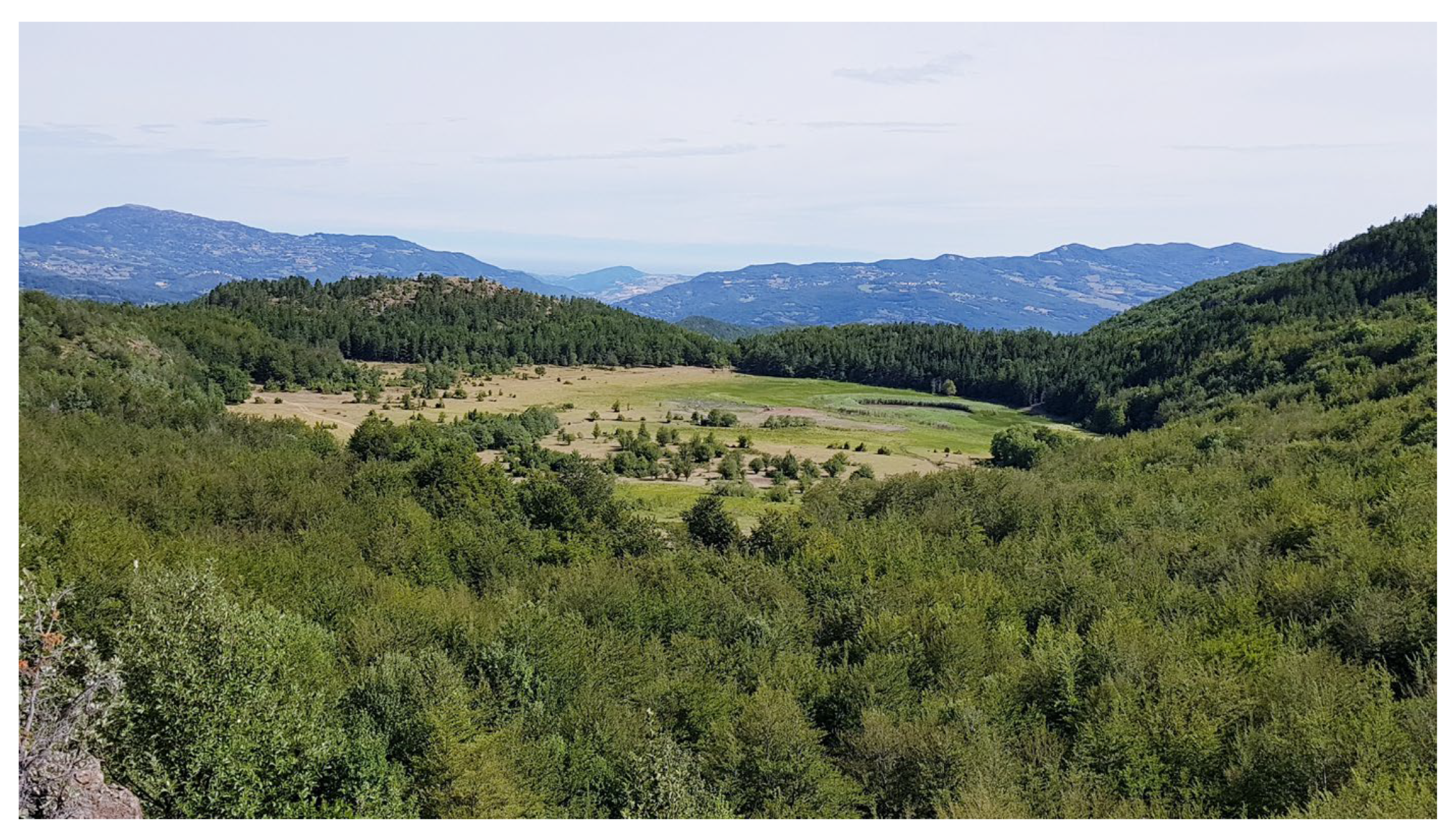
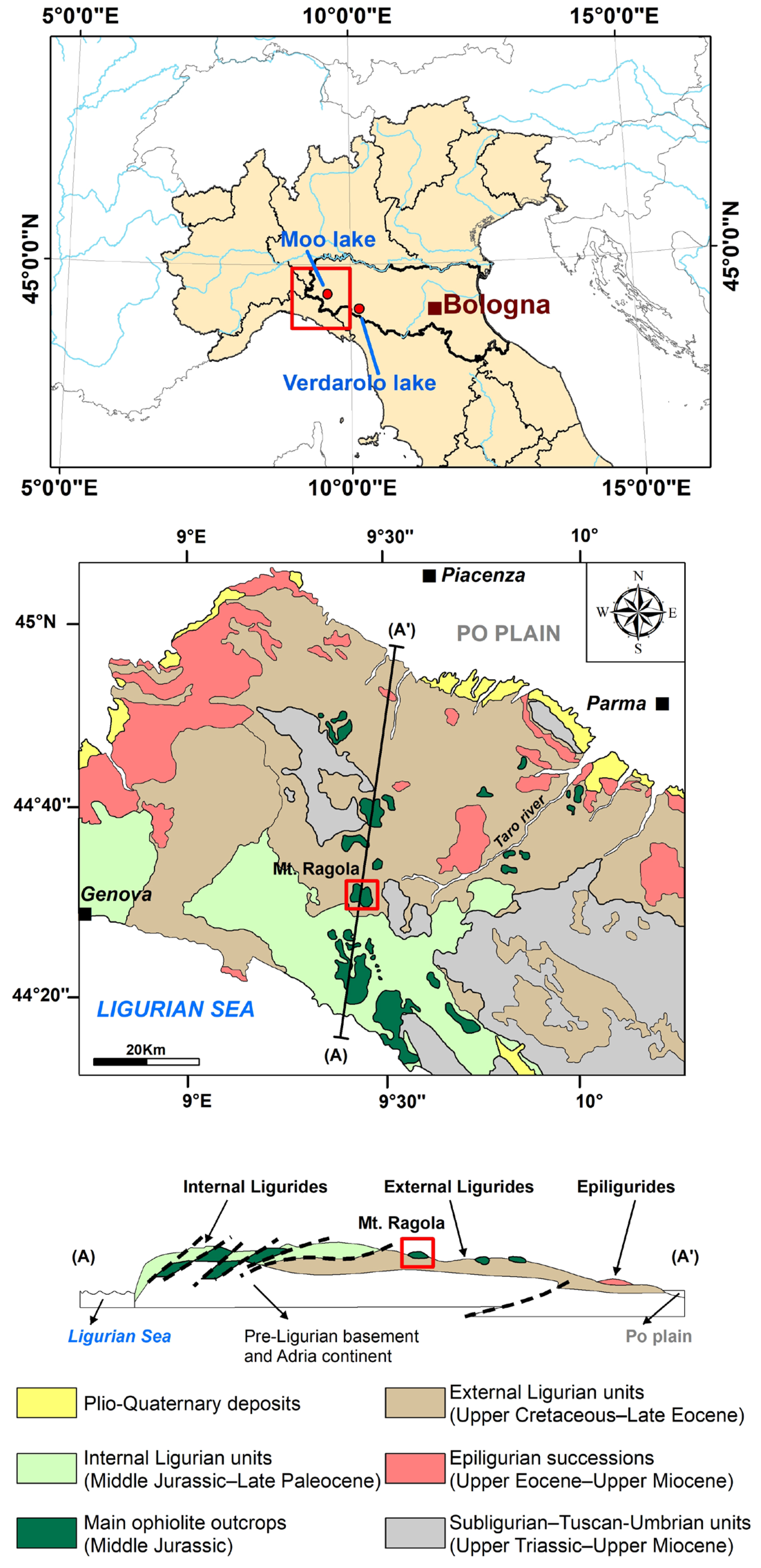



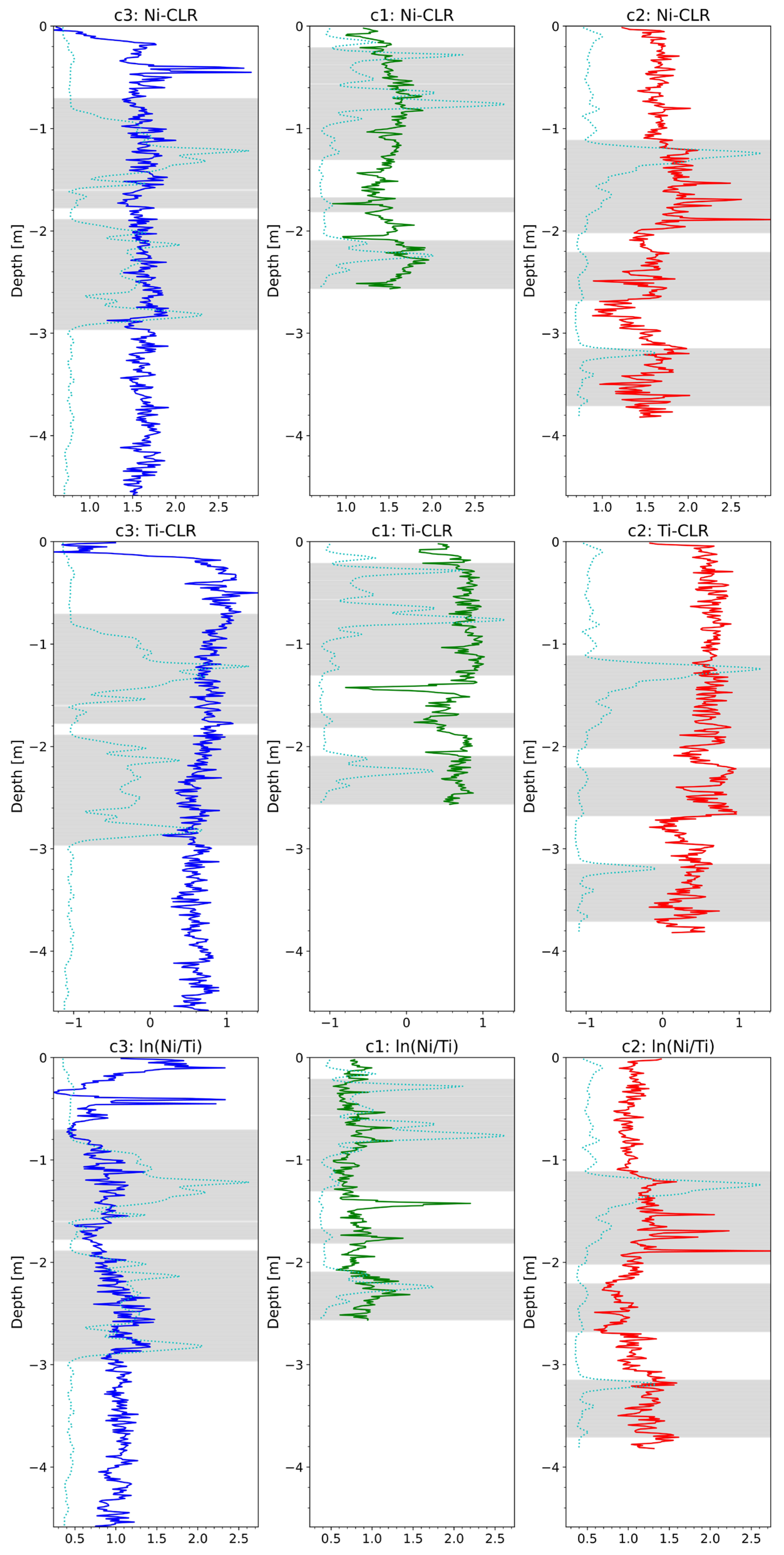
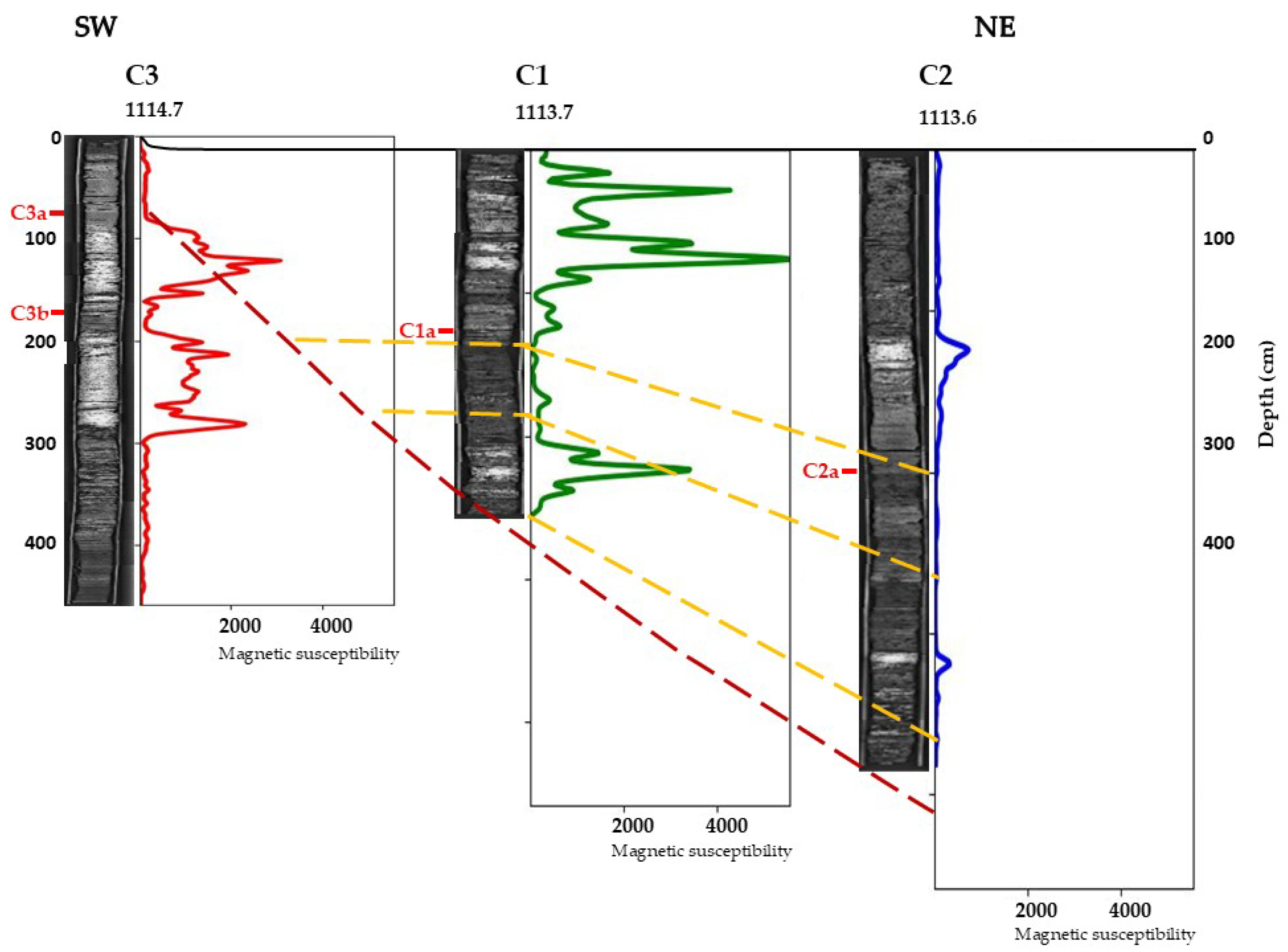
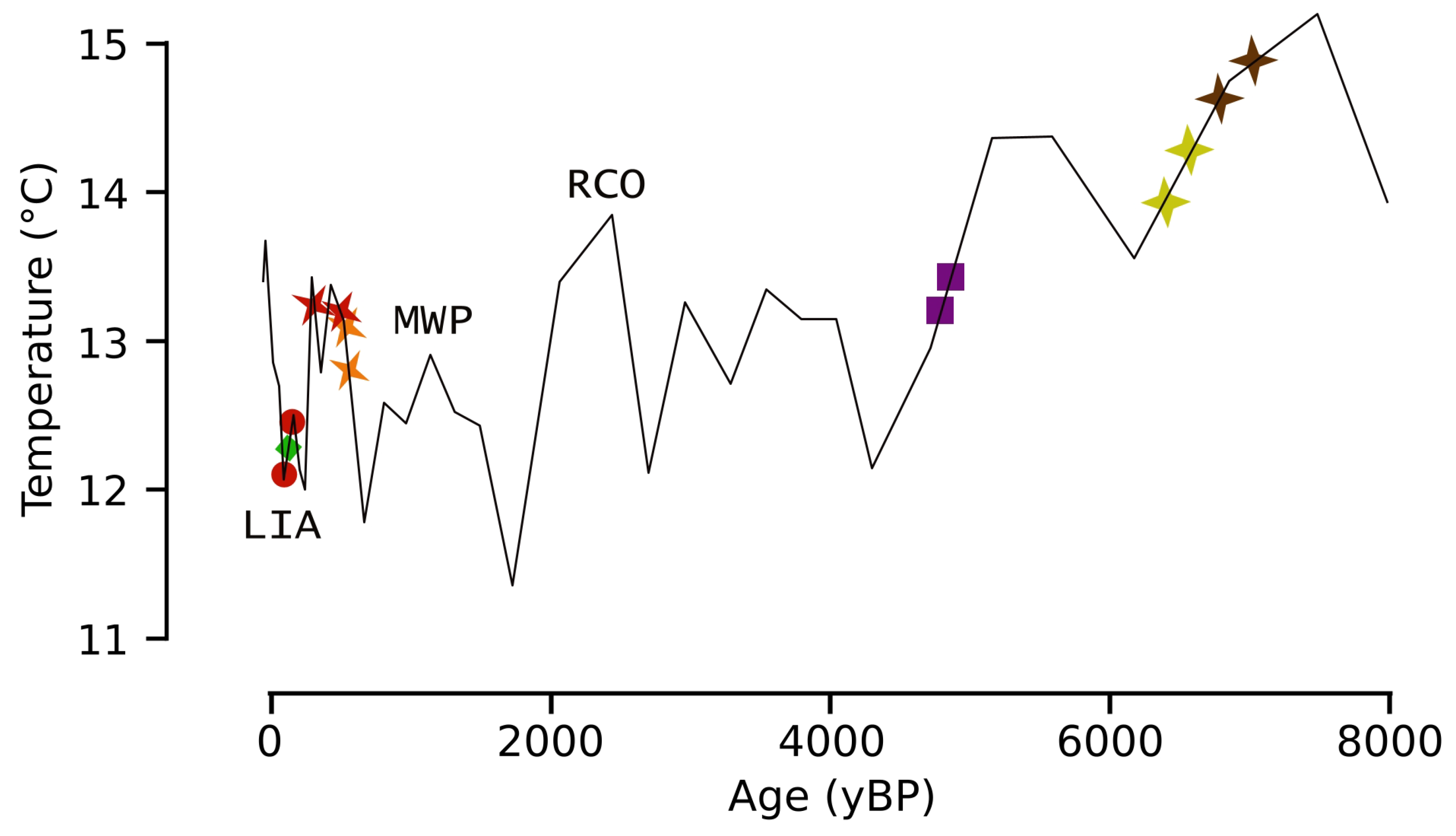
| Core Code | Latitude | Longitude | Depth (cm) | Recovery (cm) | Recovery Percentage (%) |
|---|---|---|---|---|---|
| C1 | 44.62478 | 9.54167 | 311 | 271 | 87% |
| C2 | 44.62524 | 9.54166 | 553 | 405 | 75% |
| C3 | 44.62455 | 9.54128 | 556 | 452 | 81% |
| Core Code | Core Depth (cm) | Material | Calibrated Age B.P. (±2 Sigma) | Calibrated Range BC/AD (±2 Sigma) |
|---|---|---|---|---|
| C3a | 70 | Woody frustules | 7–35 26–35 | 1957–1985 CE 1976–/1985 CE |
| C3b | 176.7 | Woody frustules | 4860–4656 4754–4716 4667–4656 | 2910–/2706 BCE 2804–/2766 BCE 2717–/2706 BCE |
| C2a | 200 | Rootlets | 514–310 | 1436–/1640 CE |
| C1a | 129.5 | Rootlets | 624–600 556–520 | 1326–1350 CE 1394–/1430 CE |
Disclaimer/Publisher’s Note: The statements, opinions and data contained in all publications are solely those of the individual author(s) and contributor(s) and not of MDPI and/or the editor(s). MDPI and/or the editor(s) disclaim responsibility for any injury to people or property resulting from any ideas, methods, instructions or products referred to in the content. |
© 2025 by the authors. Licensee MDPI, Basel, Switzerland. This article is an open access article distributed under the terms and conditions of the Creative Commons Attribution (CC BY) license (https://creativecommons.org/licenses/by/4.0/).
Share and Cite
Nestola, Y.; Segadelli, S. New Data from Minor Mountainous Lakes as High-Resolution Geological Archives of the Northern Apennines, Italy: Lake Moo. Geosciences 2025, 15, 217. https://doi.org/10.3390/geosciences15060217
Nestola Y, Segadelli S. New Data from Minor Mountainous Lakes as High-Resolution Geological Archives of the Northern Apennines, Italy: Lake Moo. Geosciences. 2025; 15(6):217. https://doi.org/10.3390/geosciences15060217
Chicago/Turabian StyleNestola, Yago, and Stefano Segadelli. 2025. "New Data from Minor Mountainous Lakes as High-Resolution Geological Archives of the Northern Apennines, Italy: Lake Moo" Geosciences 15, no. 6: 217. https://doi.org/10.3390/geosciences15060217
APA StyleNestola, Y., & Segadelli, S. (2025). New Data from Minor Mountainous Lakes as High-Resolution Geological Archives of the Northern Apennines, Italy: Lake Moo. Geosciences, 15(6), 217. https://doi.org/10.3390/geosciences15060217







